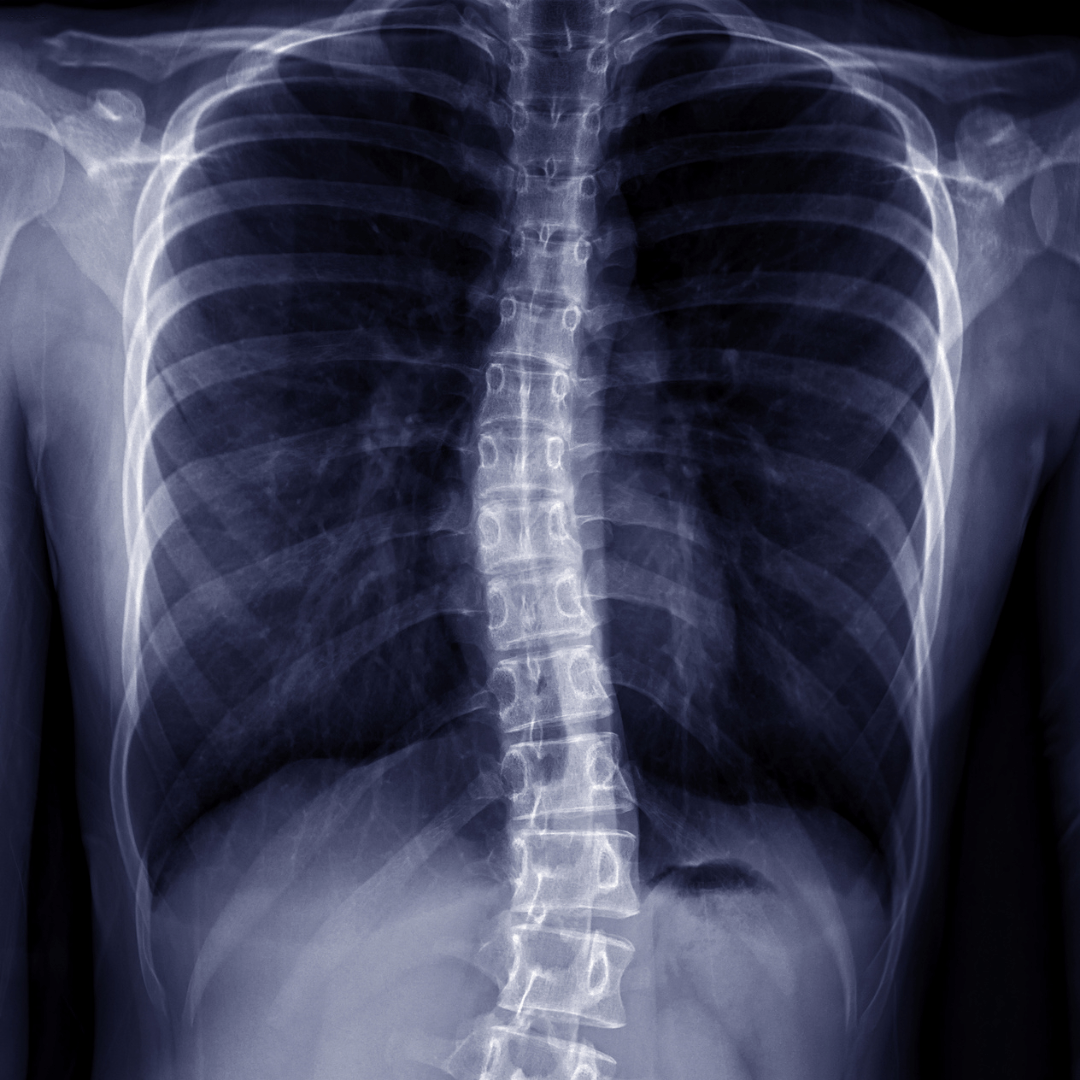
Featured Doctor
Derek Ju, MD
Get to know Dr. Derek Ju, a fellowship-trained and board-certified orthopedic spine surgeon at Orthopaedic Associates of Manhasset.
View Profile

As an orthopedic spine surgeon, scoliosis awareness is important to me. It highlights the need for early detection and treatment of scoliosis, which can greatly improve outcomes and quality of life. Below, you’ll find information on the basics of scoliosis: its types, symptoms, diagnosis, and treatment options, to help you understand and manage this condition.
What is scoliosis
Scoliosis is an abnormal side-to-side curvature of the spine. When looking at a person with scoliosis from the front, his or her spine may be more shaped like a “C” or a “S”. This can lead to the shoulders and/or hips being uneven. If the curve is large enough, it can cause problems with lung function.
Scoliosis can affect people of any age, but those most affected are adolescents. There are many different types of scoliosis. The most common form is called Adolescent Idiopathic Scoliosis. Idiopathic means that we do not know the true cause. In adults, the most common form of scoliosis is Adult Degenerative Scoliosis, meaning that it results from asymmetric degeneration of the spine as a person ages.
While far less common, there are also other types of scoliosis, such as congenital scoliosis, which is caused by a defect present at birth, and neuromuscular scoliosis, which occurs as a secondary condition resulting from disorders like cerebral palsy and muscular dystrophy.
What are the symptoms of scoliosis?
The majority of scoliosis cases are mild, and the symptoms can vary in degree depending on the case. Common signs and symptoms include:
- Uneven shoulders or waist
- One shoulder blade or one side of the ribcage appears more prominent than the other
- A noticeable curve in the back, particularly from behind
- In severe cases, back pain and difficulty breathing due to reduced chest space for the lungs
- Adults may experience weakness, numbness, and/or pain radiating into the lower extremities. This is from nerve pinching and is much less commonly seen in adolescents
How is scoliosis diagnosed?
Screening Adolescents:
Adolescents are often screened for scoliosis using the Adam’s forward bending test. In this test, the patient bends forward to touch their toes. A healthcare provider uses a device called a scoliometer to measure the rotation of the spine. Some smartphone apps can also help parents perform at-home screenings. If there is a concern for scoliosis, an X-ray is typically done.
Confirming the Diagnosis:
An X-ray that shows a spine curvature of more than 10 degrees confirms scoliosis. Adults are diagnosed in the same way.
Further Imaging:
Depending on the severity of the scoliosis and the need for surgery, additional imaging tests like a CT scan or MRI may be needed to get a more detailed view of the spine.
How is scoliosis treated?
The treatment for scoliosis depends on its type and severity. Adolescent Idiopathic Scoliosis and Adult Degenerative Scoliosis have different treatment goals and methods.
Adolescent Idiopathic Scoliosis:
For teenagers with scoliosis, the main goal is to stop the curve from getting worse. How much the curve might progress depends on its size when first diagnosed and how much growing the child has left to do.
- Small Curves (less than 25°): If the curve is small, just watching it might be enough, no matter how much the child will still grow.
- Moderate Curves (25° to 45°): If the curve is moderate and the child is still growing, a brace might be recommended. Braces help when the child is growing, but if the child has finished growing, a brace might not be suggested, even for moderate curves.
- Large Curves (over 45°): For large curves, surgery might be needed. This surgery, called posterior spinal fusion, involves placing screws and rods in the back to straighten the spine and prevent further curving.
Adult Degenerative Scoliosis:
For adults with scoliosis, the focus is on relieving symptoms. The most common symptoms are pain, feeling off balance, or leg pain from pinched nerves.
- Non-surgical treatments: These are always tried first and can include medications, physical therapy, and various types of injections.
- Surgical treatments: If non-surgical treatments don’t work, surgery may be considered. The type of surgery will depend on the symptoms, treatment goals, and how the scoliosis looks on imaging tests.
We received a scoliosis diagnosis—what should we expect?
Receiving a diagnosis of scoliosis can be overwhelming. However, most cases do not require invasive treatment, and many adolescents and adults with scoliosis lead completely normal lives without any limitations. Once diagnosed, the provider will likely refer the patient to a spine specialist who will create an individualized treatment plan. This plan will be based on the type and severity of scoliosis, the patient’s symptoms, and their treatment goals. Several resources are available to help educate newly diagnosed patients and their families to better understand the condition.
The majority of scoliosis cases are mild, and the symptoms can vary in degree depending on the case. Common signs and symptoms include:
- Uneven shoulders or waist
- One shoulder blade or one side of the ribcage appears more prominent than the other
- A noticeable curve in the back, particularly from behind
- In severe cases, back pain and difficulty breathing due to reduced chest space for the lungs
- Adults may experience weakness, numbness, and/or pain radiating into the lower extremities. This is from nerve pinching and is much less commonly seen in adolescents
Screening Adolescents:
Adolescents are often screened for scoliosis using the Adam’s forward bending test. In this test, the patient bends forward to touch their toes. A healthcare provider uses a device called a scoliometer to measure the rotation of the spine. Some smartphone apps can also help parents perform at-home screenings. If there is a concern for scoliosis, an X-ray is typically done.
Confirming the Diagnosis:
An X-ray that shows a spine curvature of more than 10 degrees confirms scoliosis. Adults are diagnosed in the same way.
Further Imaging:
Depending on the severity of the scoliosis and the need for surgery, additional imaging tests like a CT scan or MRI may be needed to get a more detailed view of the spine.
The treatment for scoliosis depends on its type and severity. Adolescent Idiopathic Scoliosis and Adult Degenerative Scoliosis have different treatment goals and methods.
Adolescent Idiopathic Scoliosis:
For teenagers with scoliosis, the main goal is to stop the curve from getting worse. How much the curve might progress depends on its size when first diagnosed and how much growing the child has left to do.
- Small Curves (less than 25°): If the curve is small, just watching it might be enough, no matter how much the child will still grow.
- Moderate Curves (25° to 45°): If the curve is moderate and the child is still growing, a brace might be recommended. Braces help when the child is growing, but if the child has finished growing, a brace might not be suggested, even for moderate curves.
- Large Curves (over 45°): For large curves, surgery might be needed. This surgery, called posterior spinal fusion, involves placing screws and rods in the back to straighten the spine and prevent further curving.
Adult Degenerative Scoliosis:
For adults with scoliosis, the focus is on relieving symptoms. The most common symptoms are pain, feeling off balance, or leg pain from pinched nerves.
- Non-surgical treatments: These are always tried first and can include medications, physical therapy, and various types of injections.
- Surgical treatments: If non-surgical treatments don’t work, surgery may be considered. The type of surgery will depend on the symptoms, treatment goals, and how the scoliosis looks on imaging tests.
Receiving a diagnosis of scoliosis can be overwhelming. However, most cases do not require invasive treatment, and many adolescents and adults with scoliosis lead completely normal lives without any limitations. Once diagnosed, the provider will likely refer the patient to a spine specialist who will create an individualized treatment plan. This plan will be based on the type and severity of scoliosis, the patient’s symptoms, and their treatment goals. Several resources are available to help educate newly diagnosed patients and their families to better understand the condition.




